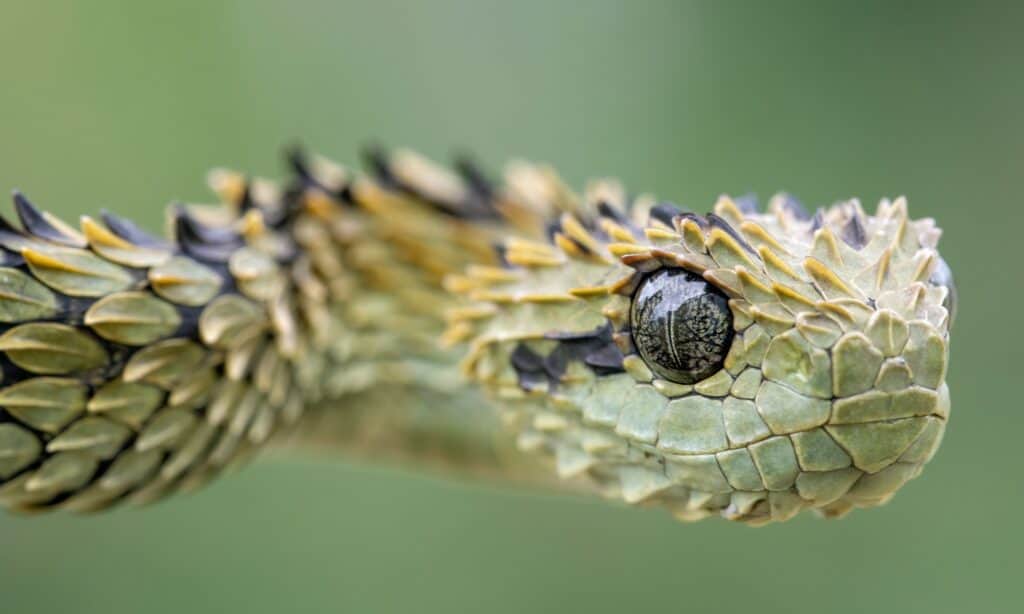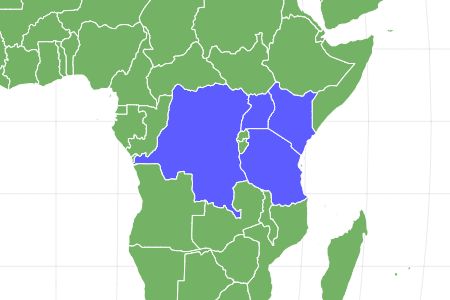Spiny bush viper
Atheris hispida
These shaggy snakes are only 2 feet long and mostly arboreal.
Advertisement
Spiny bush viper Scientific Classification
- Kingdom
- Animalia
- Phylum
- Chordata
- Class
- Reptilia
- Order
- Squamata
- Family
- Viperidae
- Genus
- Atheris
- Scientific Name
- Atheris hispida
Read our Complete Guide to Classification of Animals.
Spiny bush viper Conservation Status
Spiny bush viper Facts
- Prey
- Mammals, frogs, lizards, birds, snails
- Main Prey
- Frogs and lizards
- Name Of Young
- Neonate, snakelet
- Group Behavior
- Solitary
- Solitary except during mating season
- Fun Fact
- These shaggy snakes are only 2 feet long and mostly arboreal.
- Estimated Population Size
- Unkown
- Most Distinctive Feature
- Elongated, keeled scales.
- Other Name(s)
- African hairy bush viper, rough-scaled bush viper, bristly bush viper, and rough-scaled tree viper.
- Gestation Period
- 6-7 months
- Litter Size
- Up to 12
- Lifestyle
- Nocturnal
- Favorite Food
- Frogs and lizards
- Common Name
- Hairy bush viper
- Number Of Species
- 1
- Group
- Den, pit, bed, nest, or knot.
Spiny bush viper Physical Characteristics
- Color
- Brown
- Blue
- Green
- Skin Type
- Scales
- Lifespan
- 10-12 years
- Weight
- 2 pounds
- Length
- 23-29 inches
- Age of Sexual Maturity
- 2-3 years
- Venomous
- Yes
- Aggression
- Medium
View all of the Spiny bush viper images!
Spiny bush vipers look like real-life dragons.
Don’t let the pretty face fool you; this snake is highly venomous and, like other vipers, has retractable hypodermic needle-like fangs. They go by a few names like the dragon bush viper, African hairy bush viper, rough-scaled bush viper, bristly bush viper, and rough-scaled tree viper. These little snakes pack a punch and sport what may be the most unique camouflage of any snake.
Incredible Spiny Bush Viper Facts
- Their scales are extra long and strongly keeled – it makes them look bushy or spiny.
- They have excellent senses of smell, eyesight, and vibration that they use to avoid predators and find food.
- Spiny bush vipers can be blue, green, brown, or a combination of the three.
Scientific Name and Classification
Spiny bush vipers are members of the Viperidae family. They’re related to other vipers like Russel’s viper, the Gaboon viper, and the common adder. Their scientific name, Atheris hispida, comes from two Greek words meaning hairy and tailed.
These snakes get their name from the keeled scales on their bodies, which are rough to the point of looking like the bushes and trees where they like to hide. They go by several different names, including the African hairy bush viper, rough-scaled bush viper, bristly bush viper, and rough-scaled tree viper.
Spiny Bush Viper Appearance
These snakes fall under the “Cute but Deadly” category. They’re small, shaggy-looking snakes, and the males only grow to about 29 inches; females are even smaller at 23 inches. Spiny bush vipers have slender bodies, and in this species, the males are thinner. They have fairly large eyes with vertical pupils. This species has prehensile tails that they use to hang from tree branches.
Being vipers, their fangs are retractable and are kept folded up into the mouth when they’re not needed. Their heads reflect the space required for the venom glands that the hypodermic needle-type teeth attach to and are wide and spade-shaped; the males tend to have stubbier snouts than the females.
What sets them apart from other snake species, however, is their scalation. Spiny bush vipers have elongated, strongly keeled scales. Their scales actually stick out from their bodies and make the snakes look very rough. The shaggy look is more dramatic on their heads and smooths slightly down the length of their bodies. They can be green, blue, brown, or a mix; the color variation often makes people mistake them for other species.

Spiny bush vipers are also called hairy bush vipers.
©iStock.com/Mark Kostich
Spiny Bush Viper Behavior
These snakes are nocturnal and spend their days resting, nestled in the bushy ends of tree branches and in or around flowers. Spiny bush vipers are excellent climbers and are mostly arboreal, spending the vast majority of their lives in the trees. They are ambush predators that use their prehensile tails and unusual camouflage, waiting for prey to wander too close. Snakes of species especially like to perch on or hang from small bushes and reeds, waiting for prey.
Unlike the New World’s pit vipers, vipers don’t have heat-sensing pits. Instead, spiny bush vipers rely on their excellent sense of smell, vision, and vibratory senses to find their prey.
They’re not known to be aggressive snakes and generally prefer to escape. However, they don’t hesitate to defend themselves when threatened.
Habitat and Diet
Spiny bush vipers primarily live in the rainforests of central Africa. They inhabit parts of the countries of Uganda, Kenya, and the Democratic Republic of Congo, where the rainforests are thick with vast amounts of flowering bushes, mostly at altitudes ranging from 2,952 to 8,200 feet (900 to 2500 meters) above sea level.
However, their distribution appears to be in somewhat disconnected pockets. In a couple of the countries where they’re believed to occur, there may only be a single spiny bush viper population in an isolated area, such as Kenya and Tanzania. In Uganda, there are two locations recorded in the central portion of the country and several in the southwest.
Due to their remote locations and somewhatelusive nature, scientists know very little about the natural history of this species. Even a 2014 study on the genetic ancestry of the Atheris genus only had a single sample of A. hispida from Kenya, whereas the other species had multiple samples from several countries. However, it’s been observed in both primary and secondary forests and in cultivated shrubland. It seems fairly versatile and has been observed in tall grass, bushes, papyrus, creepers, and trees.
A spiny bush viper always has a body of water nearby, and this is possibly because of its diet. It eats frogs and lizards primarily, but small mammals, birds, and even snails also appear on their list of prey items.
Venom: How Dangerous are Spiny Bush Vipers
Surprisingly, there’s not much information on their venom. Some sources indicate that it’s neurotoxic; others say it’s hemotoxic venom. One thing scientists do know is that toxicity varies depending on the individual snake. It’s possible (although not confirmed) that some localities have a more hemotoxic venom and others more neurotoxic – as is the case in certain rattlesnake species like the Mojave rattlesnake found in North America. The venom cocktail probably depends on the snake’s preferred prey in that region, possibly even the climate, and altitude. Regardless, spiny bush vipers are extremely dangerous, but encounters with people are relatively rare. They typically occur in isolated regions that are pretty far from human settlements.
There’s also no antivenom available for this species; your best bet is to avoid getting bitten. However, if for some reason you’re bitten by a spiny bush viper, treatments are usually supportive and administered on a symptom-by-symptom basis. Most people recover without needing much, but more severe envenomations often require hospitalization.
Predators, Threats, Conservation, and Population
This species’ wide distribution and overall commonness in the areas in which it occurs gave reason for the IUCN SSC Viper Specialist Group to classify it as a species of Least Concern on the IUCN Redlist of Threatened Species. As with other snakes in remote areas, it’s nearly impossible to get an accurate population census.
There isn’t much information on the spiny bush viper’s abundance. It’s rare in DR Congo, but in Kenya, the populations seem to cycle through abundant and rare years. There aren’t any major threats to the species at present. However, deforestation occurring at an increasing pace in those areas may change this.
Scientists don’t know much about its natural predators; it has such secretive habits that the information isn’t readily available. Of course, its rainforest home doesn’t have a shortage of predators there are other snakes and birds that are known to prey on snakes – venomous or not. With more research, scientists will have a better picture of their lifestyle.
Reproduction, Babies, and Lifespan
Spiny bush vipers become mature at 2-3 years of age. They mate during the rainy season between September and October, and the females carry the babies for 6-7 months before giving birth to up to 12 neonates in March or April.
When they’re born, they measure about 6 inches long and, in captivity, can live for 10-12 years.
Next Up
- Eyelash vipers have stunning colors and little scales that stick up from their eyes, like eyelashes.
- Another large-eyed and rough-scaled snake, saw-scaled vipers are native to most of Asia and India.
- Gaboon vipers may not look much like a spiny bush viper, but they live in the same part of the world.
Spiny bush viper FAQs (Frequently Asked Questions)
Are Spiny bush vipers venomous?
Yes, although scientists are conflicted on just how dangerous their venom is. For years, it was assumed that it wasn’t very dangerous, but then they received several reports about people dying after a bite from one. It seems that the venom varies depending on the region, and there isn’t a clear picture of just how dangerous it is as yet.
Are spiny bush vipers aggressive?
Not really, but they’re small snakes. Smaller snakes tend to operate on the idea, “If it’s bigger than me, it is out to get me.” So they’re more likely to bite out of a reaction than actual aggression.
Do spiny bush vipers make good pets?
Maybe. But only if you have experience keeping venomous snakes. The fact is that its venom may kill you, and if it doesn’t kill you, it’ll probably cost a small fortune in medical care. Remember, there’s no antivenom for this one.
How do spiny bush vipers hunt?
By ambush! Their camouflage is so good that they only have to sit and wait.
Where do spiny bush vipers live?
They live in central Africa. The jungles in the countries of DR Congo, Kenya, Uganda, and may be in Tanzania.
Thank you for reading! Have some feedback for us? Contact the AZ Animals editorial team.
Sources
- Kusamba, C., Branch, W.R., Wagner, P., Beraduccii, J. & Chippaux, J.-P. 2021. Atheris hispida. The IUCN Red List of Threatened Species 2021: e.T44980127A44980134. https://dx.doi.org/10.2305/IUCN.UK.2021-3.RLTS.T44980127A44980134.en. (2019) iucnredlist.org/species/44980127/44980134
- Toxinology.com, Available here: http://toxinology.com/fusebox.cfm?fuseaction=main.snakes.display&id=SN0195
- Menegon, M. et al. “The Genus Atheris (Serpentes: Viperidae) in East Africa: Phylogeny and the Role of Rifting and Climate in Shaping the Current Pattern of Species Diversity.” Molecular Phylogenetics and Evolution 79 (2014): 12–22. Web., Available here: https://www.academia.edu/12387141/The_genus_Atheris_Serpentes_Viperidae_in_East_Africa_phylogeny_and_the_role_of_rifting_and_climate_in_shaping_the_current_pattern_of_species_diversity
- (1970)

















